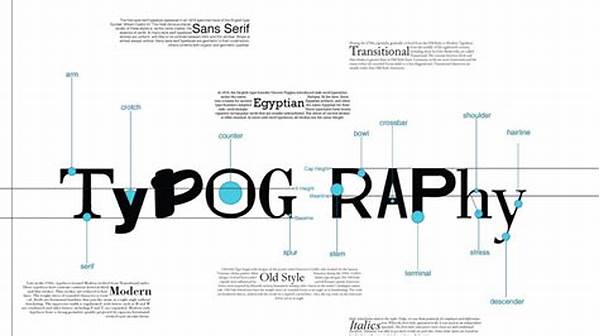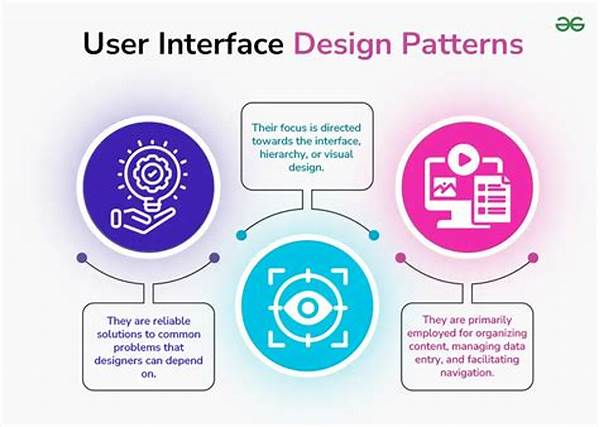In an era dominated by digital media, the importance of legibility in digital typography design has become pronounced. It defines the way users interact with text on various digital platforms, impacting both accessibility and user experience. Ensuring texts are legible is crucial, especially as digital interfaces grow increasingly complex and visually cluttered. The goal is to facilitate a seamless reading experience that caters to diverse audiences. This article explores the integral role of legibility in digital typography design, considering factors such as font choice, size, and spacing, which collectively influence legibility.
Read Now : Verifying Genuine Creativity In Digital Designs
Understanding the Basics of Legibility
Legibility in digital typography design is primarily concerned with how easily individual characters can be distinguished. This is affected by the typeface, font size, spacing, and contrast, among other factors. Choosing an appropriate typeface is vital. Some fonts, though aesthetically pleasing, can be challenging to read if not designed with digital platforms in mind. It’s important to balance style with function, ensuring that typography not only attracts visually but also communicates clearly.
The digital age has introduced varied devices and screen sizes, making responsive typography essential for legibility. What looks perfect on a desktop might not translate well to a mobile screen. Therefore, designers need to consider scalable and adaptable typography solutions. Proper line spacing or leading can greatly enhance readability, making text less cramped and more user-friendly. Additionally, contrast plays a significant part; text must stand out from the background to be easily readable across all devices and lighting conditions.
Influential Factors in Typography Design
1. Typeface Selection: Essential for enhancing legibility. It influences the user’s ability to differentiate between characters.
2. Font Size: Critical for ensuring clarity. Too small or too large can hinder legibility in digital typography design.
3. Spacing: Adequate spacing between letters and lines improves readability and prevents visual strain.
4. Contrast: Sufficient contrast between text and background is necessary for visibility and legibility.
5. Responsive Design: Adaptable typography that fits various screen sizes enhances legibility and improves user experience.
The Role of Technology in Typography
Technology amplifies the significance of legibility in digital typography design by providing tools and techniques to test and enhance text readability. Advanced software allows designers to prototype and simulate how their typography appears across different platforms. Automated tools assess contrast ratios, helping ensure text visibility. Moreover, variable fonts technology offers flexibility, allowing for adjustments in weight, width, and optical size, making designs more adaptable and accessible.
Ensuring legibility in digital typography design also involves understanding user behavior and preferences. User testing, analytics, and feedback collection are necessary to refine typographic choices continuously. Designers must consider demographic differences, such as age and visual acuity, which may influence how text is perceived. Fonts must, therefore, be chosen not solely for their aesthetic appeal but for their functional clarity.
Common Challenges in Typography Design
1. Clarity Across Devices: Ensuring typography remains legible on varying screen sizes is a constant challenge.
2. Balancing Aesthetics and Functionality: Striking a balance between visual appeal and legibility may require compromises.
3. Consistent User Experience: Maintaining uniform legibility across different browsers and platforms requires thoughtful design.
4. Technical Limitations: Device resolutions and rendering differences can affect how typography is displayed on screen.
5. Cultural and Linguistic Variability: Different languages and alphabets pose unique legibility challenges in digital typography design.
Read Now : Strengthening Artist-gallery Partnerships
6. Rapid Technological Evolution: Keeping up with emerging technologies that influence typography is crucial for designers.
7. User Diversity: Accommodating users with visual impairments or age-related vision decline necessitates careful design choices.
8. Cognitive Load Management: Text must be designed to avoid overwhelming the reader, ensuring comprehension is maintained.
9. Attention to Detail: Fine-tuning typography for maximum clarity involves detailed attention to minute aspects of type design.
10. Education and Awareness: Continuous learning about digital typography’s impact is crucial for maintaining high legibility standards.
Designing for Optimal Legibility
Creating effective legibility in digital typography design involves meticulous attention to several factors. It’s not just about selecting a font but understanding how that font interacts with other design elements. The context in which text is read, the environment’s lighting, and the user’s reading distance all play roles. Designers must consider these when crafting text for digital consumption, ensuring their work caters to different usage scenarios.
The importance of legibility in digital typography design cannot be overstated. As digital consumption becomes ubiquitous, the demand for clear and concise communication grows. Whether it’s an article on a news website, a digital billboard, or in-app text, legibility is key. Designers must emphasize clarity and ease of reading, adapting their approaches to suit evolving digital landscapes and user needs.
Implementing Best Practices
In implementing best practices for legibility in digital typography design, designers must focus on several core components. It starts with choosing a typeface that ensures maximum readability and matching it with the appropriate size for the intended use case. Attention should also be given to line length and alignment, as these contribute significantly to how text is experienced.
Ensuring sufficient contrast and utilising responsive typography principles further aid in enhancing legibility across various devices. In addition, some designers incorporate user feedback cycles, using real-world insights to continuously improve typography choices. Effective legibility in digital typography design ensures that the text serves its ultimate purpose: to be read, understood, and appreciated without visual strain.
Summary of Legibility Concerns
Addressing legibility in digital typography design is fundamental to creating effective digital content. It involves a careful balance between aesthetic expression and functional clarity, emphasizing the importance of clear and accessible text. With an ever-expanding range of devices and formats, the challenge is ensuring that typography remains consistent and legible across all platforms. This requires designers to stay informed about technological developments and user preferences while adhering to best practices in design and usability.
The importance of legibility in digital typography design lies in its ability to facilitate seamless communication in an increasingly digital world. A well-designed typographic system considers the challenges posed by different screen sizes and resolutions, aiming for a universal design that honors both stylistic choices and readability. Thus, legibility is not just a design trend but a necessary consideration in the era of digital communication.



